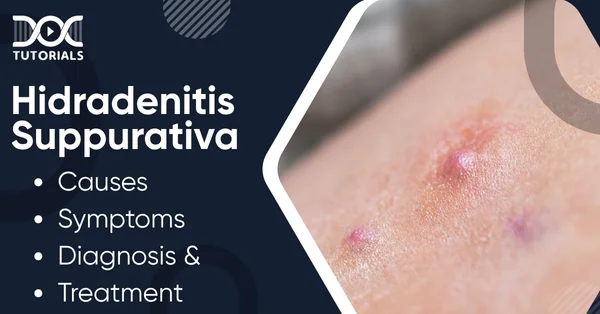Hidradenitis Suppurativa: Causes, Symptoms, Diagnosis, And Treatment

Also known as acne inversa, hidradenitis suppurativa (HS) is a chronic, inflammatory, and relapsing skin disease. It affects the areas where skin-on-skin friction occurs most. Painful nodules, abscesses, and scarring form on skin folds such as the underarms, groin region, or under the breasts.
HS can have extreme effects on a person’s physical and mental health. Therefore, if you’re an aspiring NEET PG student, understanding immunological and inflammatory disorders is crucial to understanding modern medicine.
This article will explain hidradenitis suppurativa, its causes, symptoms, diagnosis, and treatment. Keep reading for detailed insight.
What is Hidradenitis Suppurativa (HS)?
Hidradenitis suppurativa is a long-term skin disease (chronic) characterised by the following:
- Deep-seated Nodules: Lumps under the surface of the skin.
- Abscesses: A localised accumulation of pus within the tissue (here, skin tissue) that forms lumps on the skin. On bursting, they produce a strong odour.
- Sinus Tracts: It is also known as skin channels; these narrow pathways connect the abscesses under the skin.
HS can develop after puberty and before age 40. The signs of HS temporarily fade on their own and then reappear again in the nearby areas; this is the hallmark of a chronic, relapsing condition, which is not contagious.
What are the Causes of Hidradenitis Suppurativa (HS)?
The hidradenitis suppurativa causes are unknown, and researchers initially believed that the reason was sweat gland blockage (occlusion). Recent reports confirm that HS-related symptoms occur due to the blockage of hair follicles, which are present in regions of the body where there is a high concentration of sweat glands.
Genetics is a probable cause for an individual to have hidradenitis suppurativa. Some cases of HS can be associated with the NCSTN (Nicastrin), PSEN1 (presenilin 1), or PSENEN (presenilin enhancer, gamma-secretase subunit) gene mutation.
These genes contain information about the proteins that are part of the γ (gamma)-secretase components involved in the Notch signalling pathway. This signalling pathway separately supports the normal growth of sweat glands and hair follicles. Thus, affected pathways disrupt normal development and immune responses, resulting in the formation of nodules and lesions.
What are the Risk Factors of Hidradenitis Suppurativa (HS)?
The risk factors for hidradenitis suppurativa include:
- Genetic Predisposition: HS is known to be passed on in families. It follows an autosomal dominant pattern, which means that inheriting a single altered gene from either parent can cause the disorder.
- Gender: Women are three times more likely to have HS than men.
- Race: Black people and mixed-race people are more prone to having this skin disease.
- Age: People have a higher chance after puberty (20s to 40s).
- Obese: The symptoms of HS are more severe in people who are obese and overweight.
- Smokers: Tobacco smokers are at high risk of developing HS.
What are the Symptoms of Hidradenitis Suppurativa (HS)?
Previously known as Verneuil’s disease, HS is marked by the development of painful boils under the skin, leading to deep-rooted skin inflammation and chronic lesions. These appear on intertriginous areas (skinfolds) like the armpits, groin area, under the breasts, nape of the neck, or the anus. These are the regions where skin friction and sweat are most common.
The symptoms usually begin with:
- Appearance of clusters of blackheads.
- A small-sized, painful lump that stays for weeks.
- A tenderness and itching occur before the lump appears.
- Redness in the affected area.
The signs of HS are considered mild, intermediate, and severe based on the Hurley staging system. Listed below are the stages along with their respective symptoms:
- Stage I
Stage I is the initial form of the disease. The patient will notice singular or multiple abscesses in the skin. This stage does not show signs of sinus tracts or scarring.
- Stage II
In stage II, multiple abscesses (alone or widely spaced) become noticeable. The boils developed under the skin may break. Sinus tracts will be prominent, and the patient might experience scarring.
- Stage III
The widespread growth of abscesses, the formation of sinus tracts, and scarring characterise the most severe form of the disease.
The abscesses usually break and reappear in the same region or nearby. The recurrence can be painful and uncomfortable. The ruptured lumps produce a strange-smelling pus. The pain and smell can have negative psychosocial effects on people, including self-consciousness, isolation, and even depression.
What is the Diagnosis of Hidradenitis Suppurativa (HS)?
There are no special tests to diagnose hidradenitis suppurativa (HS). However, the dermatologist will determine the condition by:
- The location of the lumps and boils.
- Certain features are clinically unique to HS and are visible only to the trained eye.
- Talking about the recurrence of lumps and understanding if anybody in their family history has this skin condition.
If the lesions start leaking, the doctor might collect some of that fluid for testing. They will culture the fluid to rule out other skin conditions and check the presence of squamous cell carcinoma, which can only develop in critical stages.
HS is also one of the most misdiagnosed skin conditions. Several skin conditions mimic hidradenitis suppurativa in their initial stages. These include:
- Acne vulgaris
- Furunculosis
- Folliculitis
- Pilonidal disease
- Crohn’s disease
- Infected epidermoid cysts
- Herpes
Since these conditions share symptoms similar to those of early-stage HS, the diagnosis of this condition is often delayed.
What are the Treatments for Hidradenitis Suppurativa (HS)?
HS currently has no known cure. Its chronic condition makes it prominent that the patient would need help to manage it over a long time. The hidradenitis suppurativa medications and treatments include:
- Warm compress during the initial stages.
- Non-steroidal anti-inflammatory drugs (NSAIDs) can help with the pain and manage the swelling. These over-the-counter drugs include:
- Aspirin
- Ibuprofen
- Naproxen
- The doctor will prescribe antibiotics to fight infections. The commonly prescribed medications are:
- Doxycycline
- Minocycline
- A combination of clindamycin and rifampin if the former is ineffective.
- Corticosteroid injections in the bumps to ease inflammation and swelling. In severe cases, the patient may be asked to take oral steroid pills.
- Oral retinoid pills such as acitretin and isotretinoin are used in severe cases.
- Taking birth control pills has worked for some women.
- Medications for the immune system include:
- Adalimumab
- Infliximab (not FDA-approved, but doctors still use it)
- Anakinra, canakinumab, and ustekinumab (usually prescribed in severe situations)
- The doctors will perform surgery in cases of deep skin bumps. In cases of small recurring bumps, they will make a small incision to drain the pus (deroofing). Skin grafting and laser surgeries are also considered for HS.
- Lifestyle changes that can help are:
- Losing weight
- Quitting smoking
- Not shaving the problematic spots
- Wearing loose and comfortable clothes
- Consulting with a dietitian
- Keeping the spots clean with antibacterial soap
What are the Complications of Hidradenitis Suppurativa (HS)?
If hidradenitis suppurativa is delayed initially, its severity will accelerate over time and have complications, such as the following:
- Secondary infection
- Negative psychosocial effect
- Lymphoedema
- Squamous cell carcinoma
- Anaemia
- Fistulas
FAQs About Hidradenitis Suppurativa (HS)
- What is the main cause of hidradenitis suppurativa?
Although the real cause is unknown, HS is caused by the blockage of hair follicles in the skinfolds, and its symptom is the formation of lesions.
- Is HS contagious?
The underlying cause of HS is neither viral nor bacterial. So, it is not contagious and cannot be passed from one person to another.
- Can HS be prevented?
No, HS cannot be prevented. However, medications and lifestyle changes can significantly help manage the condition.
- Can diet affect hidradenitis suppurativa?
Yes, a balanced, anti-inflammatory diet will help manage flare-ups. Although advice from a dietitian is recommended.
Conclusion
Hidradenitis Suppurativa was once considered a rare disease, as its symptoms often overlapped with other conditions. However, now it affects 1 in 100 people, and the risks are high if there is a history of HS in the family. So, if you’re a NEET PG aspirant, you need to understand the clinical features of the condition and its treatments.
At DocTutorials, we provide exceptional NEET PG study materials with question banks and video tutorials. Our expert guidance and NEET PG test series will ensure your success in the exam. Join DocTutorials and check out our NEET PG course now!
Latest Blogs
-

NEET PG Exam 2025- Date, Pattern, Marking Scheme, Subject Wise Weightage, and Exam Mode
NEET PG Exam 2025 is the ultimate gateway for medical graduates aspiring to pursue postgraduate courses in medicine, including MD,…
-

INI CET Exam 2025: Your Roadmap to Success – Key Topics, Strategies, and Lessons from Last Year’s Papers
The INI CET exam is more than just a test; it’s a significant milestone for many medical students aiming to…
-

INI CET Exam Success: Previous Year Question Papers & Ultimate Guide – INI CET PYQ
One can feel overwhelmed while preparing for the INI CET (Institute of National Importance Combined Entrance Test). A vast syllabus,…




